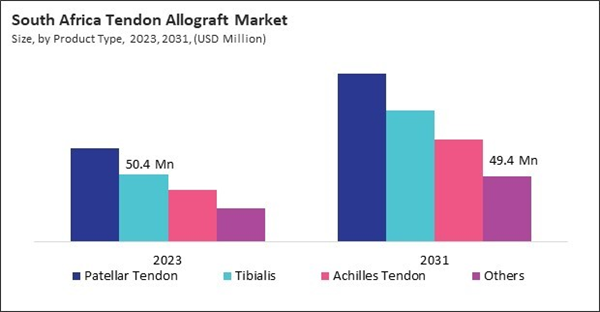The Brazil market dominated the LAMEA Tendon Allograft Market, by Country in 2023, and is forecast to continue being a dominant market till 2031; thereby, achieving a market value of $699.8 Million by 2031. The Argentina market is showcasing a CAGR of 8.7% during (2024 - 2031). Additionally, The UAE market would register a CAGR of 6.8% during (2024 - 2031).
Biomechanical properties are critical for the success of tendon allografts. These properties determine how well the graft can withstand mechanical stresses and integrate with the host tissue. Researchers are focusing on improving the strength, elasticity, and durability of tendon allografts to ensure they can perform effectively under the physiological conditions of the human body.
The development of next-generation tendon allografts is often the result of collaborative efforts between academia, industry, and healthcare institutions. These partnerships combine the expertise and resources of different sectors to accelerate innovation and bring advanced solutions to the market. In Australia, the collaboration between the University of Sydney, the Australian Institute of Sport, and tissue engineering companies has led to significant advancements in tendon allograft technology. Their joint efforts have focused on creating bioengineered tendon allografts that incorporate growth factors and stem cells to enhance healing and regeneration. These bioactive grafts stimulate the body's natural repair processes, resulting in faster and more effective recovery.
In the United Arab Emirates (UAE), the demand for tendon allografts is driven by substantial healthcare expenditure. The investment has resulted in state-of-the-art medical facilities and the adoption of cutting-edge surgical techniques. The Emirates Orthopaedic Society highlights the rising number of tendon repair surgeries, supported by increased funding for both public and private healthcare sectors. The availability of high-quality tendon allografts and the preference for biologic solutions over synthetic implants contribute to the growing demand in the UAE. Thus, all the elements mentioned above will drive the market's growth.
List of Key Companies Profiled
- INTEGRA LIFESCIENCES HOLDINGS CORPORATION
- Conmed Corporation
- RTI Surgical, Inc.
- Arthrex, Inc.
- Organogenesis Holdings, Inc.
- Zimmer Biomet Holdings, Inc.
- B.Braun Melsungen AG (Aesculap, Inc.)
- Stryker Corporation
- MIMEDX Group, Inc.
Market Report Segmentation
By End User- Hospitals
- Orthopedic Clinics
- Others
- Patellar Tendon
- Tibialis
- Achilles Tendon
- Others
- Brazil
- Argentina
- UAE
- Saudi Arabia
- South Africa
- Nigeria
- Rest of LAMEA
Table of Contents
Companies Mentioned
- INTEGRA LIFESCIENCES HOLDINGS CORPORATION
- Conmed Corporation
- RTI Surgical, Inc.
- Arthrex, Inc.
- Organogenesis Holdings, Inc.
- Zimmer Biomet Holdings, Inc.
- B. Braun Melsungen AG (Aesculap, Inc.)
- Stryker Corporation
- MIMEDX Group, Inc.









